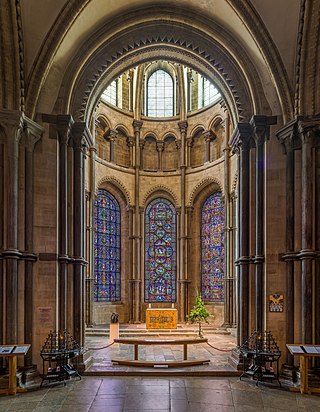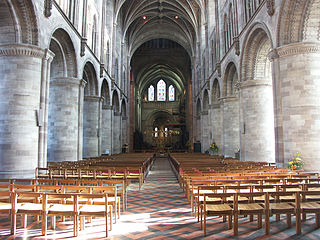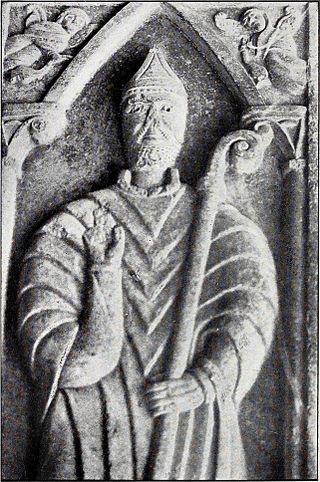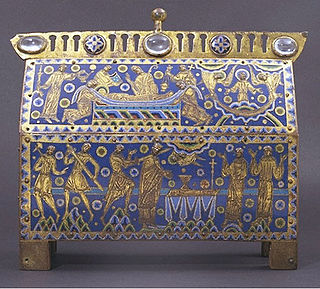Ælfheah, more commonly known today as Alphege, was an Anglo-Saxon Bishop of Winchester, later Archbishop of Canterbury. He became an anchorite before being elected abbot of Bath Abbey. His reputation for piety and sanctity led to his promotion to the episcopate and, eventually, to his becoming archbishop. Ælfheah furthered the cult of Dunstan and also encouraged learning. He was captured by Viking raiders in 1011 during the siege of Canterbury and killed by them the following year after refusing to allow himself to be ransomed. Ælfheah was canonised as a saint in 1078. Thomas Becket, a later Archbishop of Canterbury, prayed to Ælfheah just before his murder in Canterbury Cathedral in 1170.

Thomas Becket, also known as Saint Thomas of Canterbury, Thomas of London and later Thomas à Becket, served as Lord Chancellor from 1155 to 1162, and then as Archbishop of Canterbury from 1162 until his death in 1170. He engaged in conflict with Henry II, King of England, over the rights and privileges of the Church and was murdered by followers of the King in Canterbury Cathedral. Soon after his death, he was canonised by Pope Alexander III. He is venerated as a saint and martyr by the Catholic Church and the Anglican Communion.

Henry IV, also known as Henry Bolingbroke, was King of England from 1399 to 1413. Henry was the son of John of Gaunt, Duke of Lancaster, and Blanche of Lancaster.

Canterbury Cathedral is the cathedral of the archbishop of Canterbury, the spiritual leader of the Church of England and symbolic leader of the worldwide Anglican Communion. Located in Canterbury, Kent, it is one of the oldest Christian structures in England and forms part of a World Heritage Site. Its formal title is the Cathedral and Metropolitical Church of Christ, Canterbury.
Richard was a medieval Benedictine monk and Archbishop of Canterbury. Employed by Thomas Becket immediately before Becket's death, Richard arranged for Becket to be buried in Canterbury Cathedral and eventually succeeded Becket at Canterbury in a contentious election. Much of Richard's time as archbishop was spent in a dispute with Roger de Pont L'Evêque, the Archbishop of York over the primacy of England, and with St Augustine's Abbey in Canterbury over the archbishop's jurisdiction over the abbey. Richard had better relations with King Henry II of England than Becket had and was employed by the king on diplomatic affairs. Richard also had the trust of the papacy and served as a judge for it. Several of his questions to Pope Alexander III were collected into the Decretals, a collection of ecclesiastical laws, and his patronage of canon lawyers did much to advance the study of canon law in England.
William de Vere was Bishop of Hereford and an Augustinian canon.

Amphibalus is a venerated early Christian priest said to have converted Saint Alban to Christianity. He occupied a place in British hagiography almost as revered as Alban himself. According to many hagiographical accounts, including those of Gildas, Bede, Geoffrey of Monmouth, and Matthew of Paris, Amphibalus was a Roman Christian fleeing religious persecution under Emperor Diocletian. Amphibalus was offered shelter by Alban in the Roman city of Verulamium, in modern-day England. Alban was so impressed with the priest's faith and teaching that he began to emulate him in worship, and eventually became a Christian himself. When Roman soldiers came to seize Amphibalus, Alban put on Amphibalus' robes and was punished in his place. According to Matthew Paris, after Alban's martyrdom, the Romans eventually caught and martyred Amphibalus as well.
Hugh de Puiset was a medieval Bishop of Durham and Chief Justiciar of England under King Richard I. He was the nephew of King Stephen of England and Henry of Blois, who both assisted Hugh's ecclesiastical career. He held the office of treasurer of York for a number of years, which led him into conflict with Henry Murdac, Archbishop of York. In 1153, Hugh was elected bishop of Durham despite the opposition of Murdac.

St. Dunstan's is an Anglican church in Canterbury, Kent, at the junction of London Road and Whitstable Road. It is dedicated to St. Dunstan (909-988) and gives its name to the part of the city on the left bank of the River Stour. The parish has been held in plurality with others nearby at different times, in a way that has been difficult to document. In 2010 the parish was joined with the parishes of the City Centre Parish in a new pastoral grouping, City Centre with St. Dunstan.

The Corona, Canterbury Cathedral is the east end of Canterbury Cathedral, named after the severed crown of Thomas Becket, whose shrine it was built to contain.

Gilbert Foliot was a medieval English monk and prelate, successively Abbot of Gloucester, Bishop of Hereford and Bishop of London. Born to an ecclesiastical family, he became a monk at Cluny Abbey in France at about the age of twenty. After holding two posts as prior in the Cluniac order he was appointed Abbot of Gloucester Abbey in 1139, a promotion influenced by his kinsman Miles of Gloucester. During his tenure as abbot he acquired additional land for the abbey, and may have helped to fabricate some charters—legal deeds attesting property ownership—to gain advantage in a dispute with the Archbishops of York. Although Foliot recognised Stephen as the King of England, he may have also sympathised with the Empress Matilda's claim to the throne. He joined Matilda's supporters after her forces captured Stephen, and continued to write letters in support of Matilda even after Stephen's release.

Bartholomew of Exeter was a medieval Bishop of Exeter. He came from Normandy and after being a clerk of the Archbishop of Canterbury, was made Archdeacon of Exeter in 1155. He became Bishop of Exeter in 1161. Known for his knowledge of canon law, he was involved in the Becket controversy after the appointment of Thomas Becket as Archbishop of Canterbury. After Becket's death, although he was frequently at the royal court, he mainly attended to his diocese. A number of works by him survive, including sermons and treatises on law and theology.
Events from the 1170s in England.

Nottingham alabaster is a term used to refer to the English sculpture industry, mostly of relatively small religious carvings, which flourished from the fourteenth century until the early sixteenth century. Alabaster carvers were at work in London, York and Burton-on-Trent, and many probably worked very close to the rural mines, but the largest concentration was around Nottingham. This has led to all the English medieval output being referred to as "Nottingham alabaster".

The Becket Casket is a reliquary made in about 1180–90 in Limoges, France, and depicts one of the most infamous events in English history, the murder of Archbishop Thomas Becket. Following the assassination, relics of St Thomas were placed in similar reliquaries and dispersed across the world. This 'chasse' shaped reliquary is made of gilt-copper round a wooden core, intricately decorated with champlevé enamel to tell the story of Thomas Becket through literal and symbolic imagery. An exemplary showcasing of the Limoges enamel technique, this reliquary is now located in the Victoria and Albert Museum in London, England.
William of Canterbury (floruit 1170–1177) was a medieval English monk and biographer of Thomas Becket, the Archbishop of Canterbury murdered in December 1170. He was present at the murder of the archbishop and admitted in his writings that he ran from the murder scene. Later he collected miracle stories about Becket. He also wrote a hagiography, or saint's life, of Becket, one of five written at Canterbury soon after Becket's death. William's hagiography was later used by other medieval writers who wrote about Becket.

St Thomas of Canterbury Church is a Roman Catholic Parish church in Canterbury, Kent, England. It was built from 1874 to 1875 in the Gothic Revival style. It is situated on the corner of Burgate and Canterbury Lane, west of Lower Bridge Street, opposite the grounds of Canterbury Cathedral in the centre of the city. It is the only Roman Catholic church in Canterbury, built on the site of a medieval church ; the old St Mary Magdalen’s Tower was retained. The church contains relics of Thomas Becket.

The Church of St. Thomas à Becket is the Church of England parish church of Box, Wiltshire, in south-west England. It is one of a number of churches named after Thomas Becket following his martyrdom. The church has 12th-century origins and was substantially remodelled in the 14th, 15th, 18th and 19th centuries. It is a Grade I listed building.
Saint Thomas Becket window in Chartres Cathedral is a 1215–1225 stained-glass window in Chartres Cathedral, located behind a grille in the Confessors' Chapel, second chapel of the south ambulatory. 8.9 m high by 2.18 m wide, it was funded by the tanners' guild. The furthest left of five lancet windows in the chapel, it is difficult to view and is heavily corroded by glass oxidisation, which has made its left side especially hard to read.

The tomb of Edward, the Black Prince, was built in the 14th century for Edward of Woodstock. He was the son of Edward III of England and heir apparent to the English throne until his early death from dysentery, aged 45. Due to his role in the Hundred Years' War and his characteristic black plate armour, Edward became known to history as "the Black Prince". Aware that he was dying and mindful of his legacy, his will specified his desired place of burial, and contained detailed stipulations as to the design of his tomb and that it be located in the Trinity Chapel of Canterbury Cathedral, in Kent, England, where his body is still interred.













